
How to Offer Free Shipping & How to Calculate Your Free Shipping Threshold
Nothing screams “Buy me!” to online shoppers more than these two simple words: Free Shipping.
It’s one of the most enticing offers you can give your customers and makes it an easy decision for them to buy an item online rather than driving to a nearby store. If you’re not giving some serious thought to offering this benefit to your customers, you really should. Consider this:
58 percent of shoppers will add items to their cart to qualify for free shipping if they reach a certain dollar amount.
Additionally, unexpected fees at the time of checkout scare off more than half of potential customers:
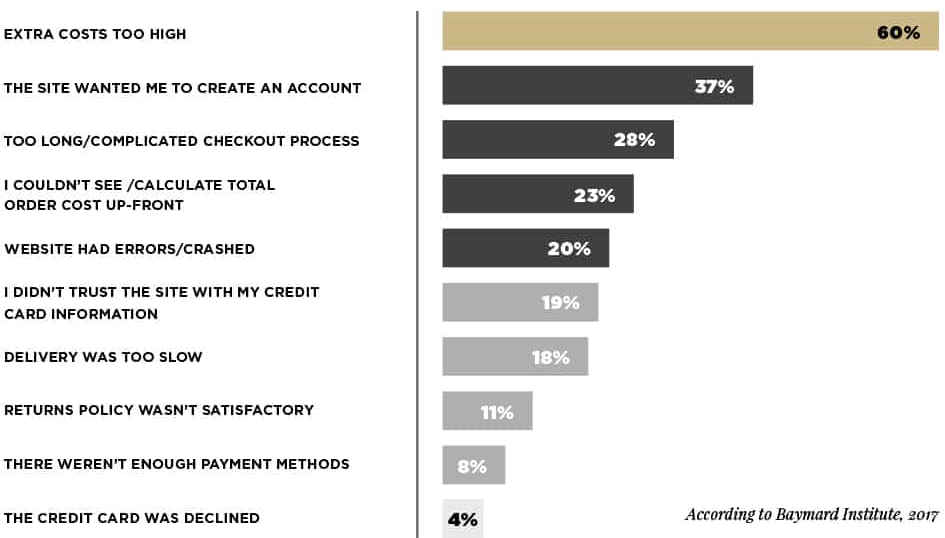
Offering free shipping is almost a guaranteed way to increase your conversion rate, and ensures customers leave your store feeling like they’ve had a positive experience. In this post-Prime era, not only do customers want free shipping, but they expect it.
You’re probably thinking, “But shipping is so expensive!” and that can be true. But if you present your offer right, you can increase your sales enough to offset the cost of it.
Free Shipping: Play the Mental Game
Shipping is a required cost of doing business online, which is partly why this “extra fee” is one that customers despise.
Shoppers will do almost anything to avoid paying for shipping; many will even add extra items to their cart just to qualify. It’s that magic word of “free” that holds all of the power – it suddenly gives them permission to buy.
Free is such a powerful word that customers would rather have something that is free than pay a tiny amount for it. Amazon put this theory into action when they rolled out free shipping in Europe, but didn’t include France. Instead of free, Amazon charged France 20 cents for shipping. When the results came in, sales were up in Europe everywhere – but not in France.
The moral of the story: Free shipping influences customer behavior at a deeply psychological level, and you can use this to your advantage:
- Give Customers a Choice: Giving customers the ability to choose between something that is free and the next cheapest option will encourage them to choose the free option – even if it means they have to add another item to their cart.
- The Power of Perceived Value: As we mentioned above, customers have a strong positive emotional response to anything that is free. The perception of free means more than any item offered at a lower price. You can choose to offer product discounts, but many customers will value “free” more, even if the monetary amount is the same. The bottom line: Free shipping gives you another lever beyond price discounts in your promotional toolbox.
Free Shipping Spotlight: Velour Lashes
Velour Lashes does this extremely well. They use free shipping to incentivize customers to add additional items to their cart throughout their shopping journey. From the moment visitors enter the site, Velour encourages them to “reach” for it.
As you can see below, Velour Lashes positions their shipping policy upfront by stating it clearly on the homepage. Their message is clear, and they tell visitors exactly how (and where) you can qualify for free shipping.
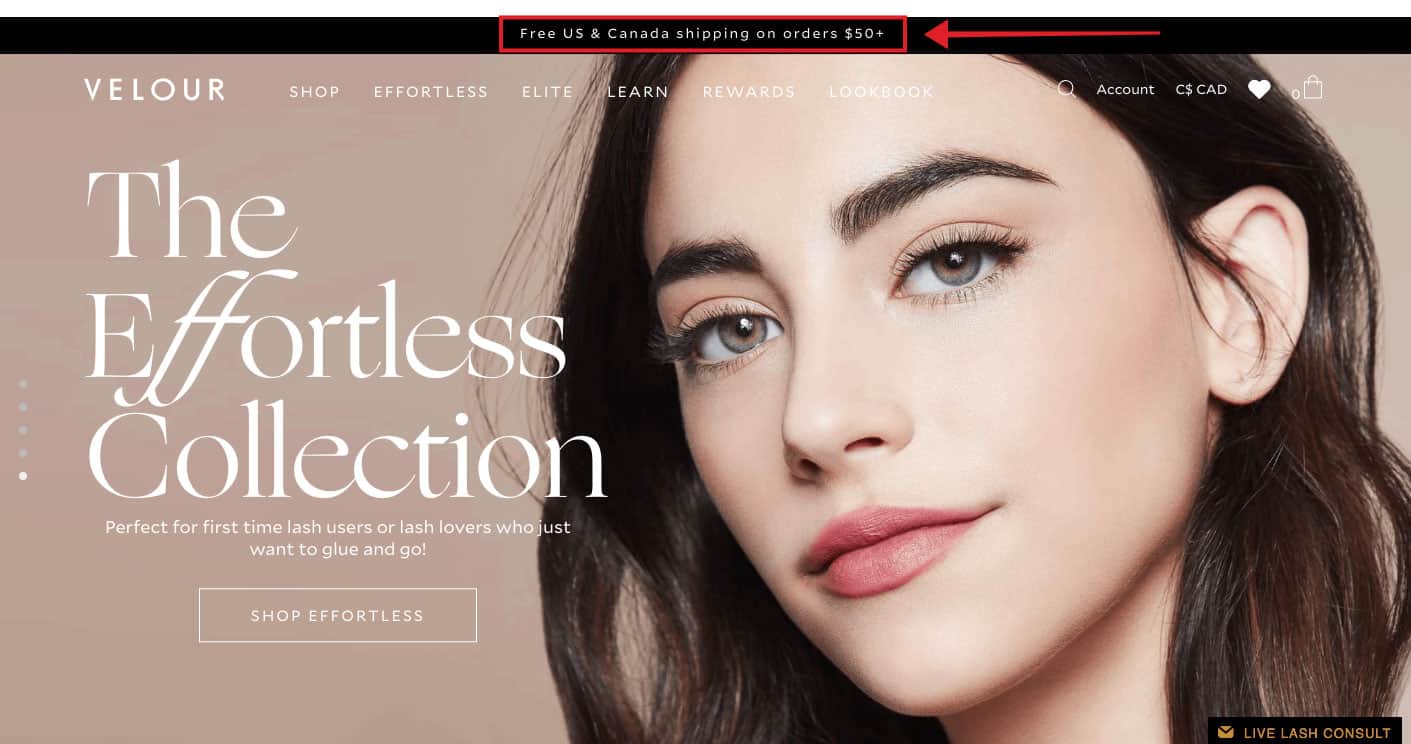
Once a customer has added an item to their cart, you can see that a message appears just below the order total to once again remind the customer that shipping can be free.

Once the customer travels to the checkout page, they will once again be hit with Velour’s shipping offer, both on the banner and above the order summary.
But Velour has taken it one step further. They add in: “You’re only $21 Away From Free Shipping!”
Telling customers the exact dollar amount they are missing to qualify for free shipping is a powerful motivator for customers to add another item to their cart.
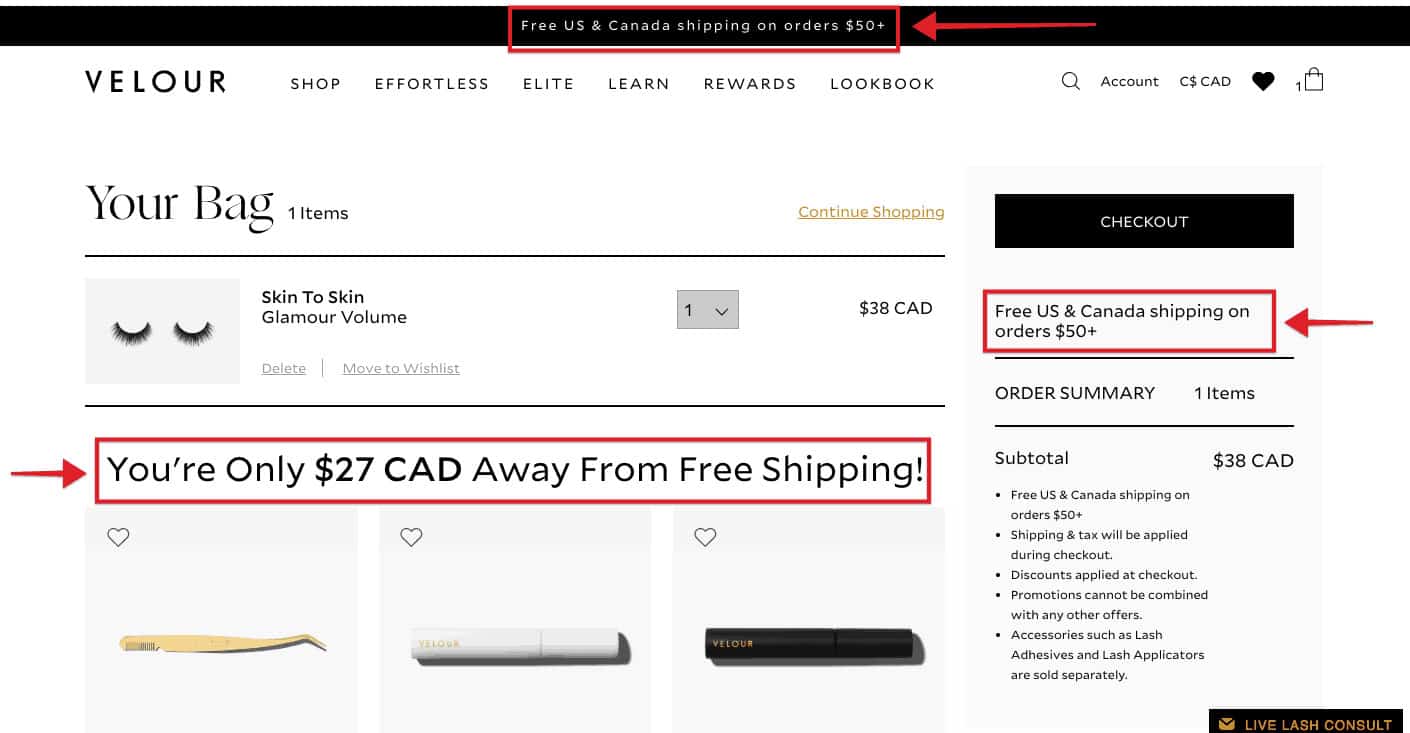
Velour then makes it very easy to tack on another item. They show a “You May Also Like” section right below the order summary that further persuades customers to act.
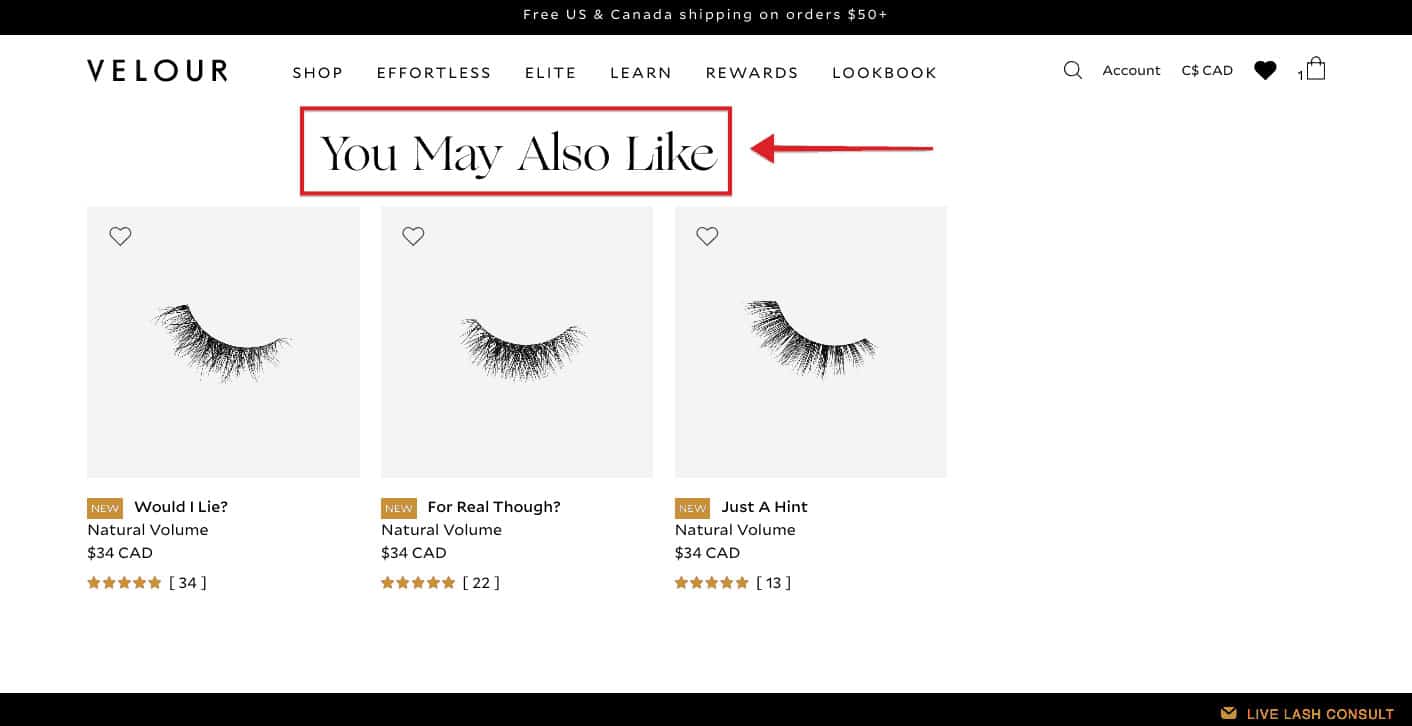
Focus on Key Metrics of Free Shipping
Free shipping is an important part of your store’s value proposition, and dialing in on the right shipping offer must be considered a key component of your overall pricing and promotional plan.
The following formula will decide which strategy is right for your business:
- Dial-in on Your Average Order Value: Your average order value can have a huge influence on whether free shipping is a viable option for your business. You’ll need to ensure you’ve got a high enough average order value to offset the extra shipping fees you take on so you aren’t losing money. In the United States, this number typically sits at around $35, but that varies depending on product weight, category, and your average shipping fees.
- Evaluate Your Competition: Sneak a peek at what your competitors are up to! Find out what their shipping policy is, and that may point you in the right direction. It can be extremely valuable to know if free shipping is expected by customers in your category. This can also help you decide how to handle your own policy: Do customers need to qualify for free shipping? Do they include the cost of shipping in the product’s price? Do they offer free international shipping? Free expedited shipping?
- Assess Your Internal Costs: You’ll want to take into account your product margins and actual shipping costs. Reviewing the price you pay for shipping (both domestic and international) to your customers will impact how you determine your shipping offer. For example, if your products are heavy or oversized, free shipping is likely not a viable (or sustainable) solution for your business.
Free Shipping Spotlight: Spy Guy
As a company that prides itself on being discreet, Spy Guy ensures their shipping policy is abundantly clear the moment visitors enter their site.
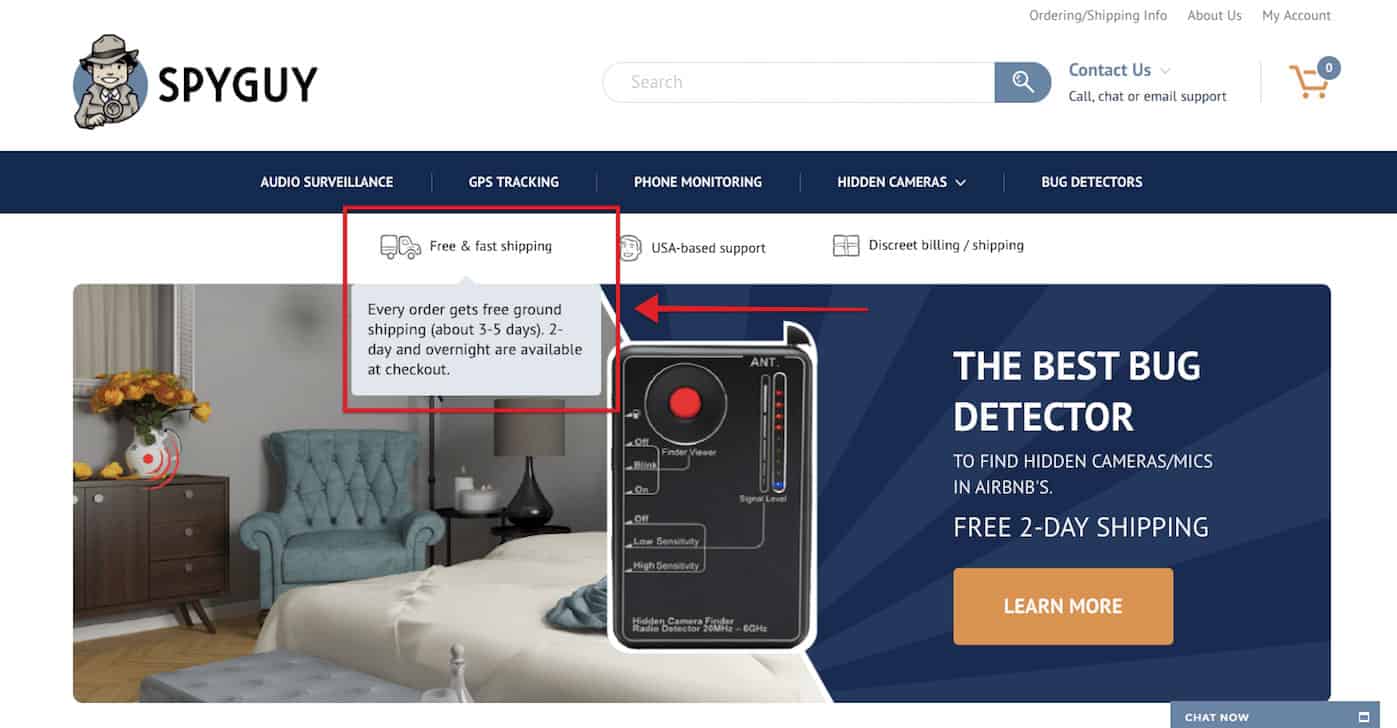
Not only does Spy Guy present their shipping offer directly on the homepage, but they’ve added a handy text box pop-up that further explains to the customer when they can expect their package.
How to Offer Free Shipping Without Losing Money
Now that you’ve done your research, it’s time to decide how to structure your free shipping offer for your customers. There are a few different strategies you can implement to ensure your free shipping offer is profitable.
- Free Shipping by Product Type: If the majority of your products are inexpensive, or even if you’re a bit skeptical about offering free shipping on every item, you can arrange for free shipping on certain products. This can be a solid option for businesses that have a smaller average order value but have some high-priced items for purchase.
- Include Shipping Prices in the Cost of the Product: This isn’t our favorite option, but it can work. Rather than eating all of the shipping fees upfront, you can absorb this cost by increasing the price of your products. Before deciding to go this route, you’ll need to do some research on your industry – your pricing still needs to remain competitive. This strategy works best for niche and unique items with limited retail distribution.
- Free Shipping Membership: Many businesses are moving towards a membership model (think Amazon Prime) which offers free shipping for its members. Shoprunner is a tool that handles this well, and it can be an option for those who want to limit free shipping to loyal, returning customers.
- Add it as an Email Promotion: Rather than giving free shipping to every customer, you could provide it to visitors who have given you a gift of their own – an email address. You can add this offer to a welcome sequence or place it in an abandoned cart email flow – this will help engage your visitors and further persuade them to act. The trick with email is to ensure that you segment domestic vs. international customers. Shipping overseas can get quite expensive, so you should be clear on who should receive this exclusive offer.
- Create a Shipping Threshold: Adding a shipping threshold can help recoup some of your shipping costs as a direct result of the boost it gives to your conversion rate and average order value. Plus, it’s a marketing tool to persuade your customers to add more items to their cart. The trick here is to ensure your threshold is set at the right number.
If none of the above options appeal to your business, you should strongly consider a flat rate for shipping. Pricing out a flat rate for all orders, regardless of the quantity, can be enough to satisfy customers and get them to press the highly coveted “purchase” button.
Free Shipping Business Spotlight: Kylie Cosmetics
As a leading business in the ecommerce cosmetics industry, Kylie Cosmetics communicates their shipping threshold the moment a visitor enters the site, and they do this for both domestic and international orders.
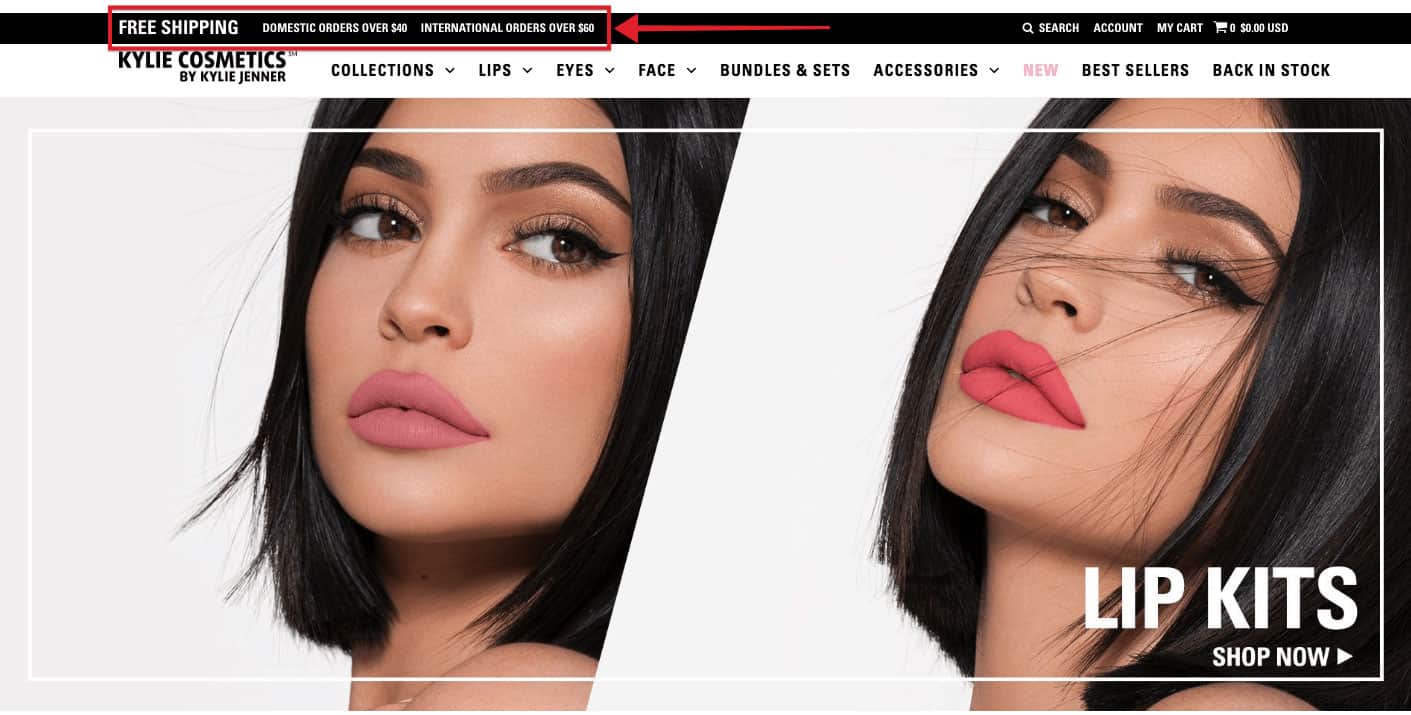
If customers need additional information on their shipping policy (especially if they do not meet the threshold requirement), Kylie Cosmetics has added a “Shipping Policy” section to their footer menu.
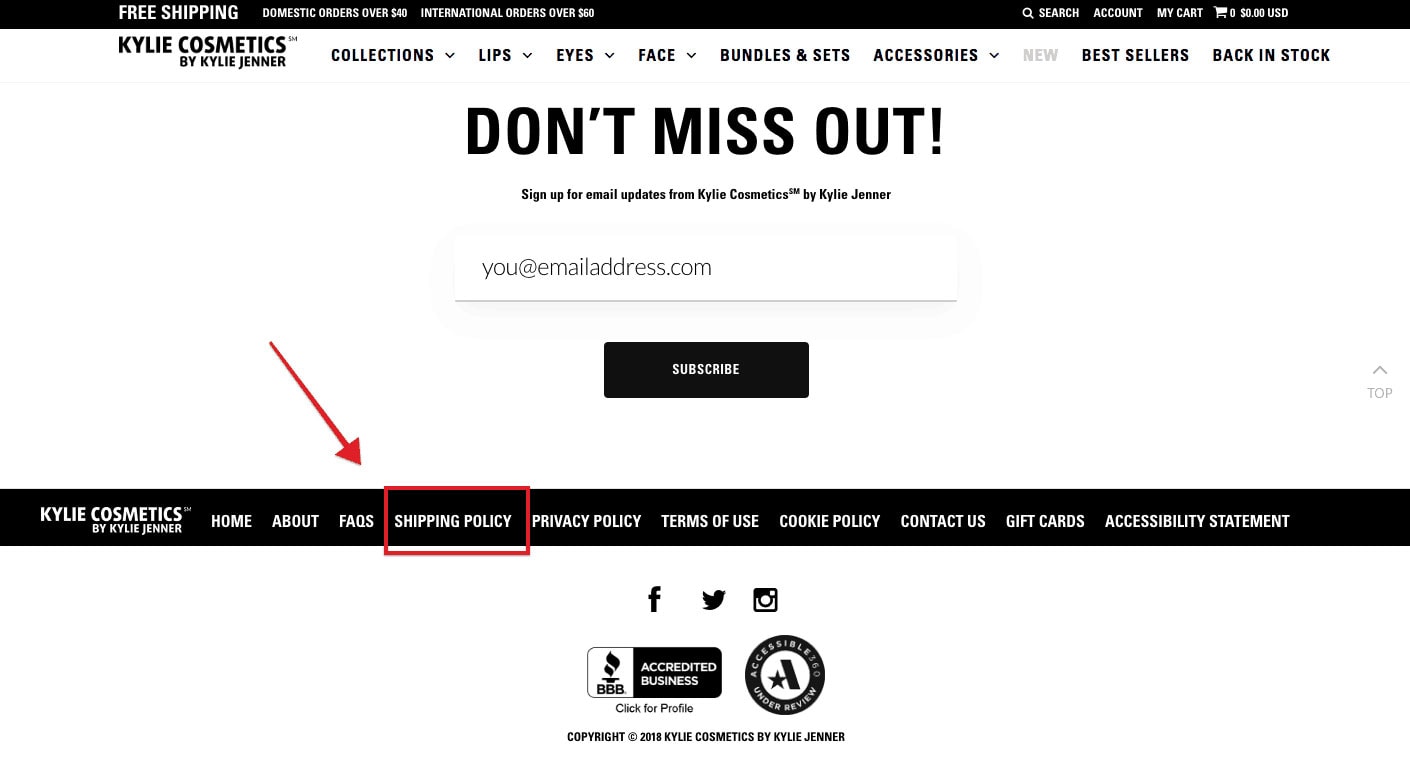
This link leads customers to a page dedicated to the specifics of their shipping policy, including the flat rate for shipping on both domestic and international orders, as well as expected processing times.
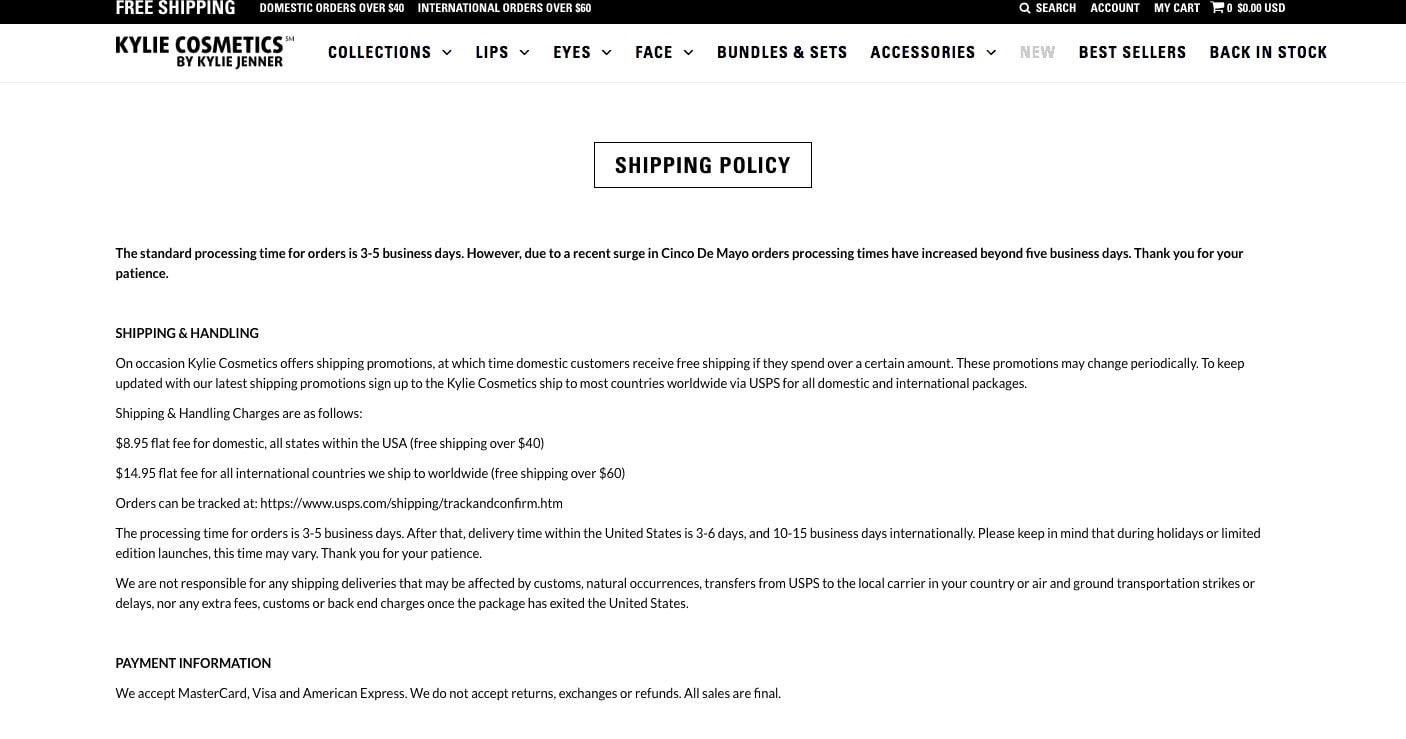
How to Calculate Your Free Shipping Threshold
I’m sure you’re asking yourself a lot of questions right now.
“If I choose to offer a shipping threshold, what should the minimum purchase be? $25? $50? $100?!”
It’s a great thought, and one you don’t want to answer arbitrarily. Ideally, your free shipping threshold needs to be close enough to what your average customer typically spends so that it encourages them to increase the size of their cart.
But you need to be careful. This number can have a real effect on your bottom line.
Set it too low, and you’re losing money.
Set it too high, and customers won’t be encouraged to buy more product(s) and your abandoned cart rates will suffer.
So you need to set it just right.
Start by Using Your Data
To better understand how to set your threshold so that it’s at the perfect price point, you’ll want to gather data from the last six to 12 months (depending on the seasonality of your business). You’ll be looking at the number of orders and the average order value.
Then you’ll want to assess this data. It should give you a good idea of where to set your threshold so you’re not losing money.
Not sure how to do this? Read on and we’ll show you how.
When the Free Shipping Threshold is Set Too Low
When the threshold is set too low in relation to the average order value, you’ll see that customers aren’t motivated to reach for free shipping.
If this is the case, your data would look like this:
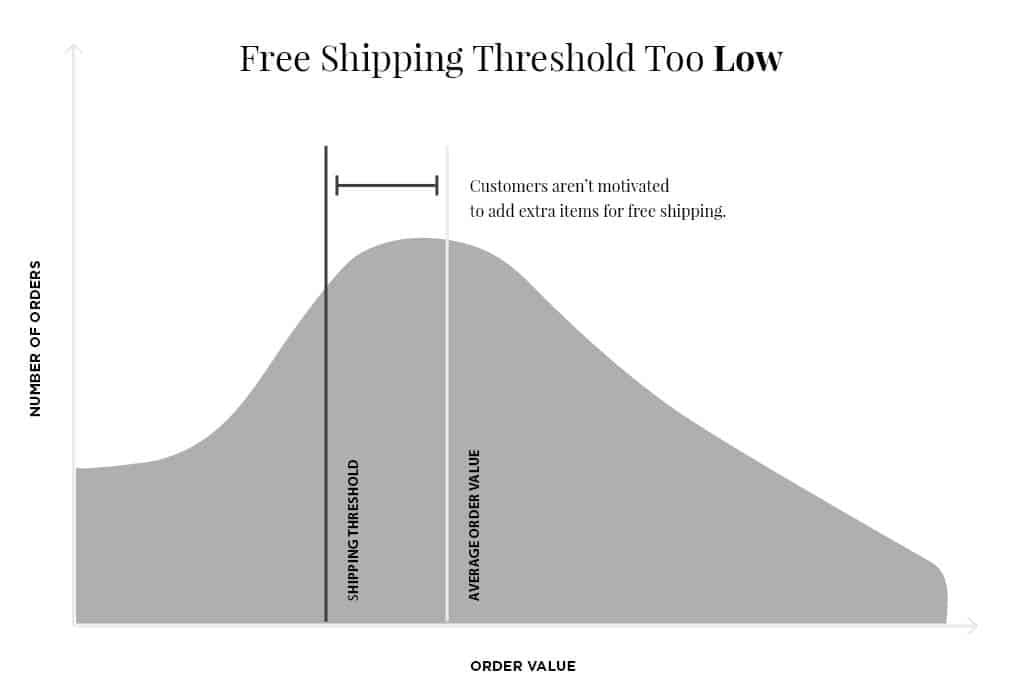
Here, the majority of your customers already qualify for free shipping, so they have no incentive to buy any additional products. In this scenario, you end up eating the cost of shipping without seeing the added benefit of a higher average order value.
When the Free Shipping Threshold is Set Too High
When your threshold is set too high, you’re asking your customers to spend too much to reach it. When visualizing your data, it might look like this:
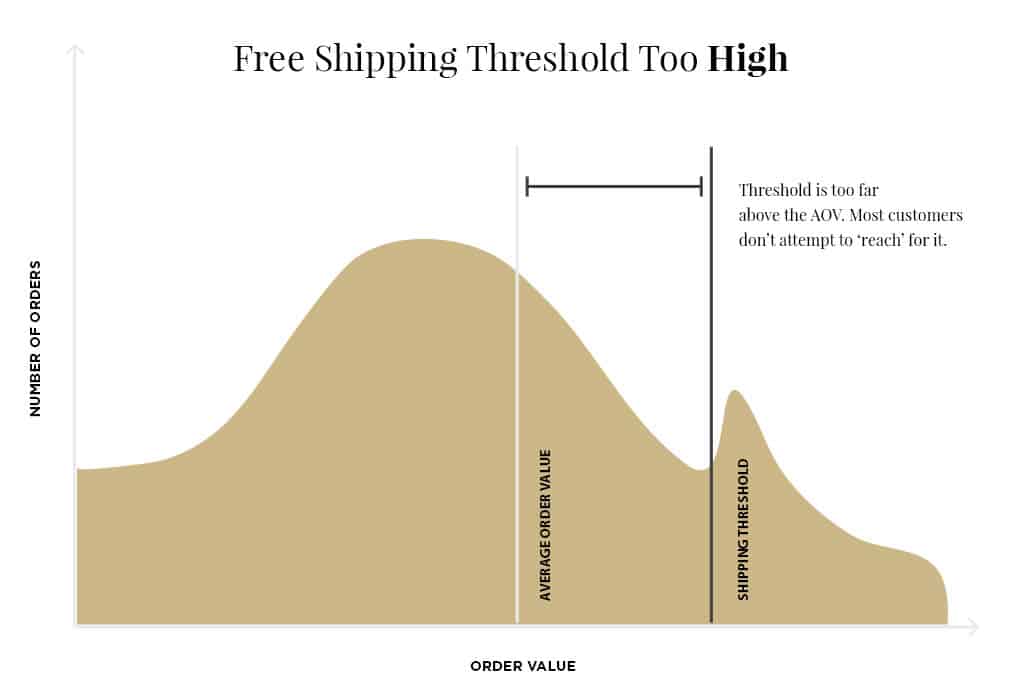
In this case, you’ll see a spike in your data right after the threshold, but you’ll see a huge dip between the highest number of orders and the threshold itself. This means your customers aren’t willing to spend more money to receive it.
In simple terms: If the threshold is set at $100 and your average order value is $50, customers won’t be willing to double up their order to get the offer. Your better option is to lower the threshold so that it’s attainable for the average customer.
When the Free Shipping Threshold is Just Right
Now that you’ve seen how the data looks in the two (unwanted) scenarios above, let’s take a look at what it looks like when the threshold is set just right.
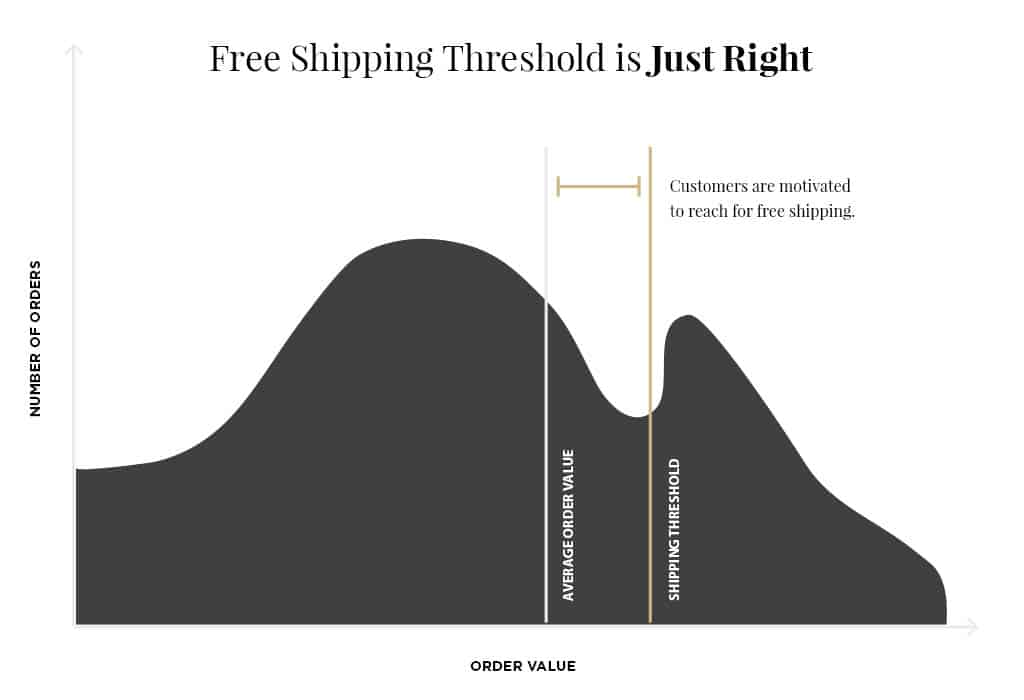
You’ll see that the highest number of orders fall just below the threshold, but not too far below it: Customers are willing to add some more items to qualify. It’s at this point when customers are more likely to impulse buy (never underestimate the power of impulse buying… we’ve all done it!).
A good rule of thumb is about 10 to 20 percent above your average order value. But this number will vary depending on your average order value, as well as your standard shipping and return policies.
Alright, now you’re ready to find your own threshold! But before you run off to do that, you should keep a few things in mind.
Free Shipping Threshold Implementation Tips:
- Communicate Your Threshold Clearly: The marketing and messaging surrounding your free shipping threshold will have a big effect on how customers respond to it. You’ll want to communicate the threshold early and very clearly. You can do this through a banner (as shown in the examples above), as well as directly on your product pages.
- Scope Out Your Competitors: It’s good to take a look at what some of your competitors are doing in your space. If they are all offering free shipping at a $50 threshold, setting yours at $100 likely won’t give you much of a boost.
- Domestic vs. International Orders: Shipping overseas can get quite expensive, so your shipping threshold may be set too low for international orders. If you sense this might be the case, you should segment your data and do a separate analysis for each. If it’s not cost-effective to ship internationally, consider offering different shipping options for those orders.
- Test, Test & Test: Before you make your free shipping threshold a policy, try running it as a promotion. Test out the number for two to four weeks, and then run through the data again. Hopefully, you’ll see a nice boost to both your conversion rate and your average order value. If it’s working – hurrah! Continue reaping the rewards. If it’s not, consider adjusting your threshold and then test… again! You can even repeat this process with different thresholds until you find out which one works best.
You should keep in mind that merchants often lower their shipping thresholds and even offer free expedited shipping for seasonal promotions and other peak seasons. To stay ahead of the game, you should monitor this on an ongoing basis, just like you would pricing and other discounts.
Free Shipping Business Spotlight: GYMSHARK
Gymshark has seen an enormous amount of growth in the past few years, and they communicate their shipping threshold the moment readers land on their homepage through the use of a banner.

Gymshark has opted to use a slider in the banner, which also highlights their return policy.
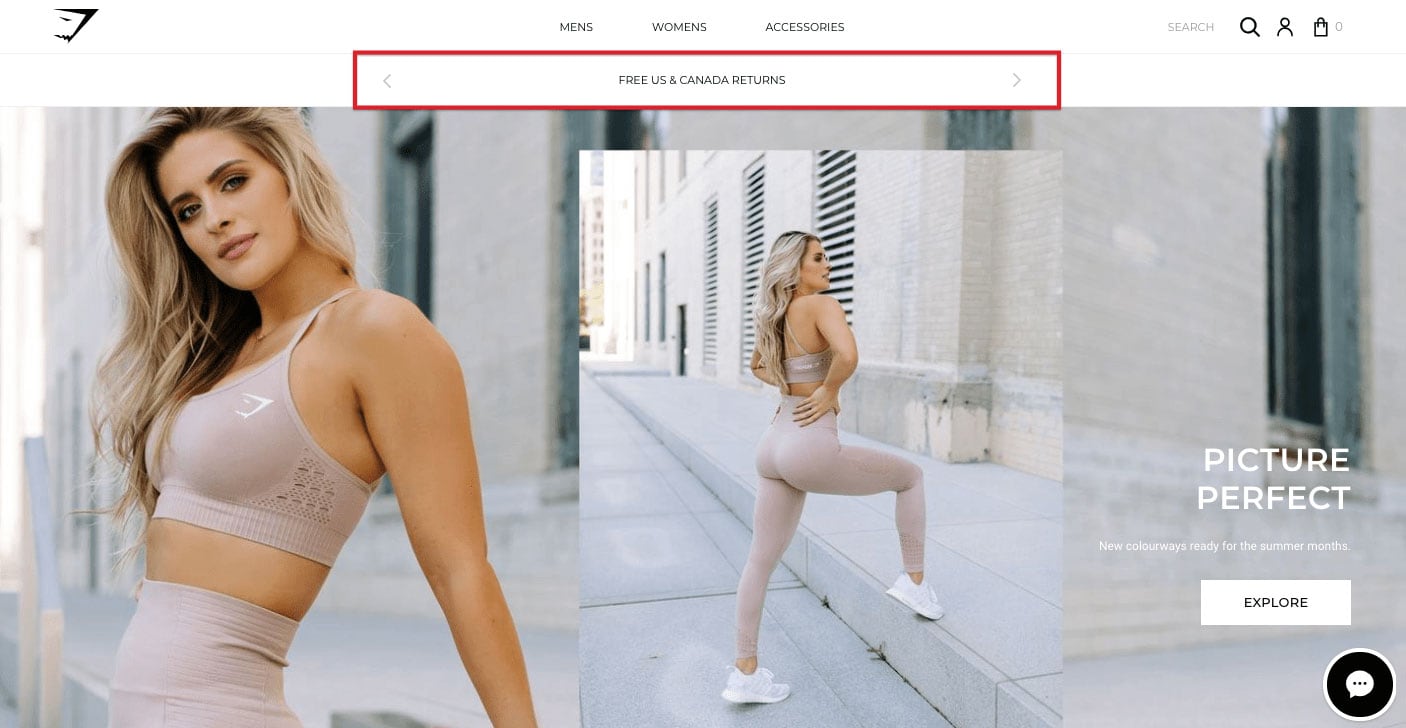
This banner links to the shipping policy page, giving readers easy access to the information they need in regards to the cost and timing of international shipping.
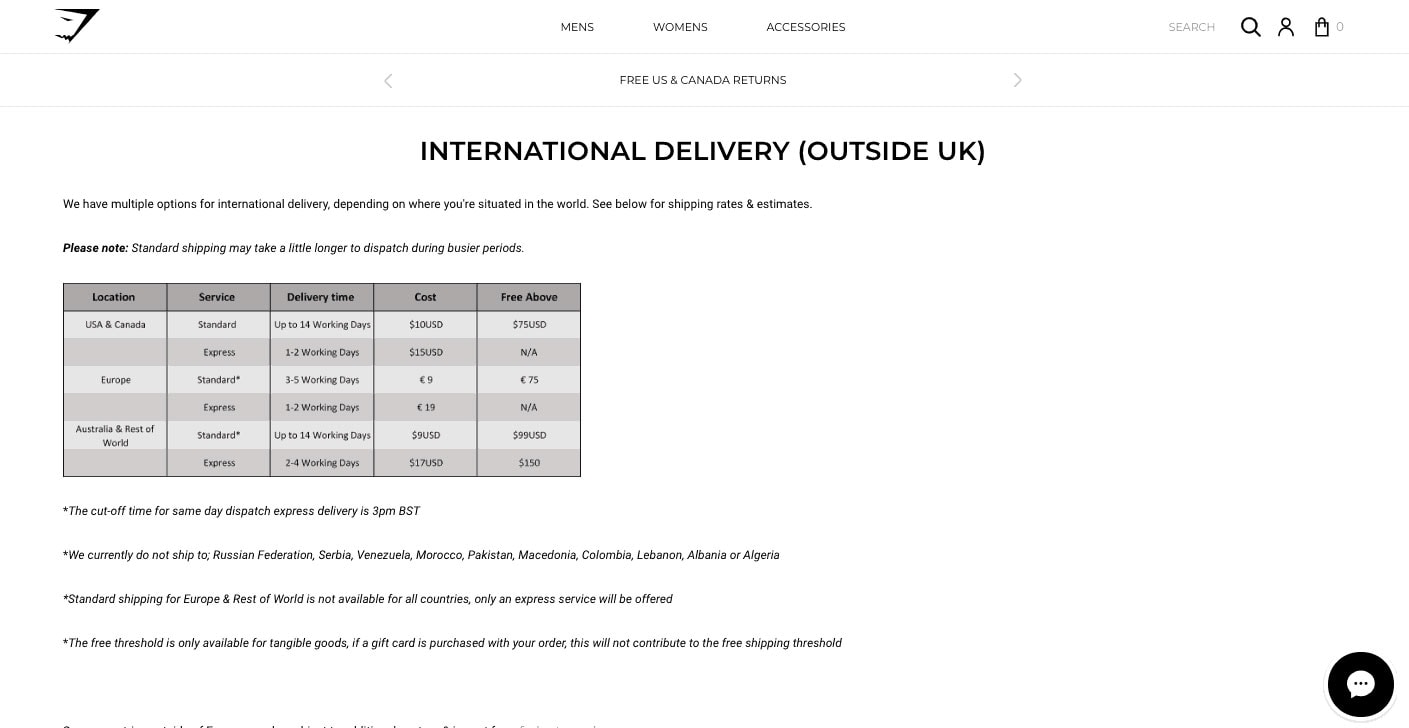
How to Handle Free Shipping Returns
Returns are one of the obvious downsides to online shopping. It’s best to come up with a standard policy to handle such requests, and you’ll want to find a balance between good customer service and what makes financial sense.
Look at your margins and shipping costs, as well as how often returns might happen. Then you’ll want to check out your competitors to see what they’re doing.
You’ve got a few options:
- Pay the full shipping price on all returns
- Require the customer to pay for any returns
- Offer a flat rate for any returns (you can price this differently for both domestic and international orders).
Either way, no matter which route you choose, you’ll need to be as transparent as possible.
Free Shipping Business Spotlight: Luxy Hair
Luxy Hair has a very thorough shipping and returns policy, and they communicate it quite well. They’re a premium clip-in hair extensions company, and they encourage customers to review the details of their shipping policy the moment they enter the website. You can see they have included a “See details” link alongside their shipping promotion in the banner on their homepage.
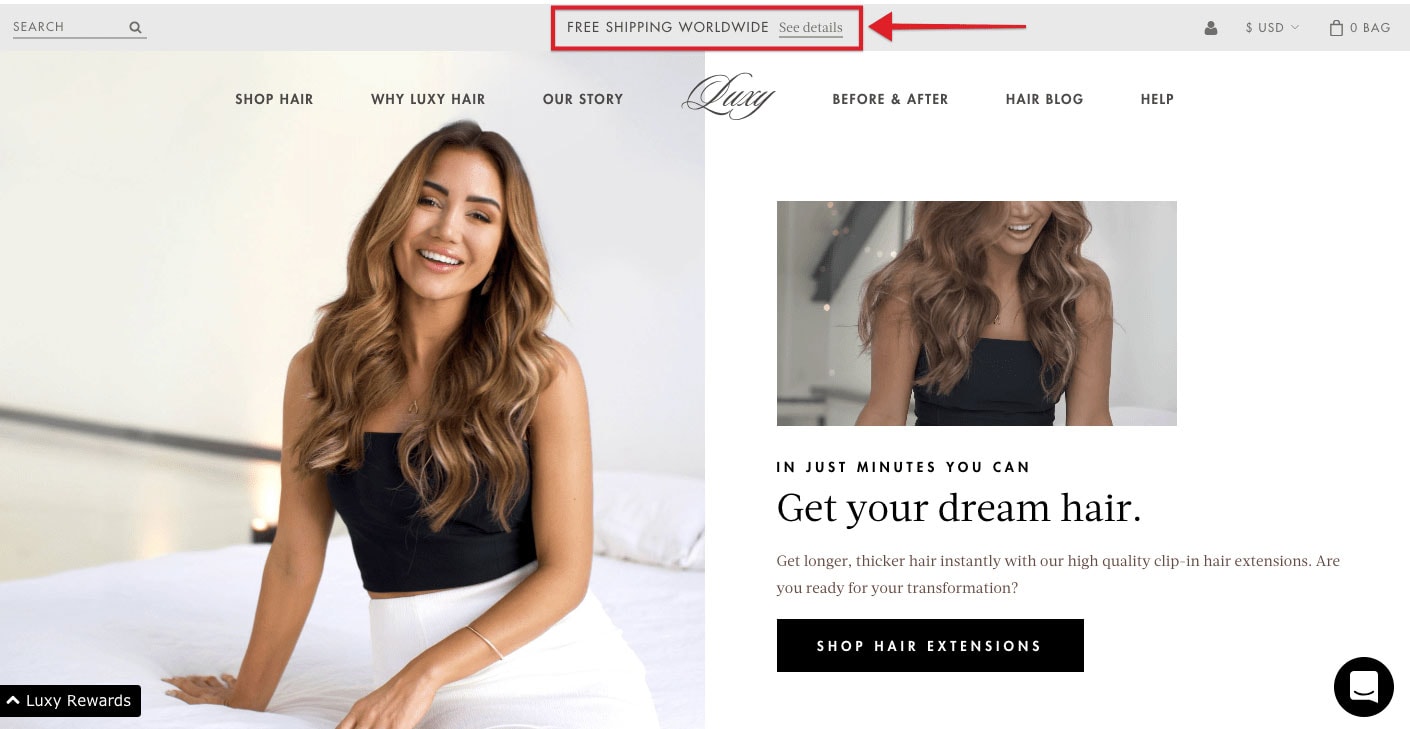
Once customers click for more details, they are directed to a page that answers heaps of shipping questions.
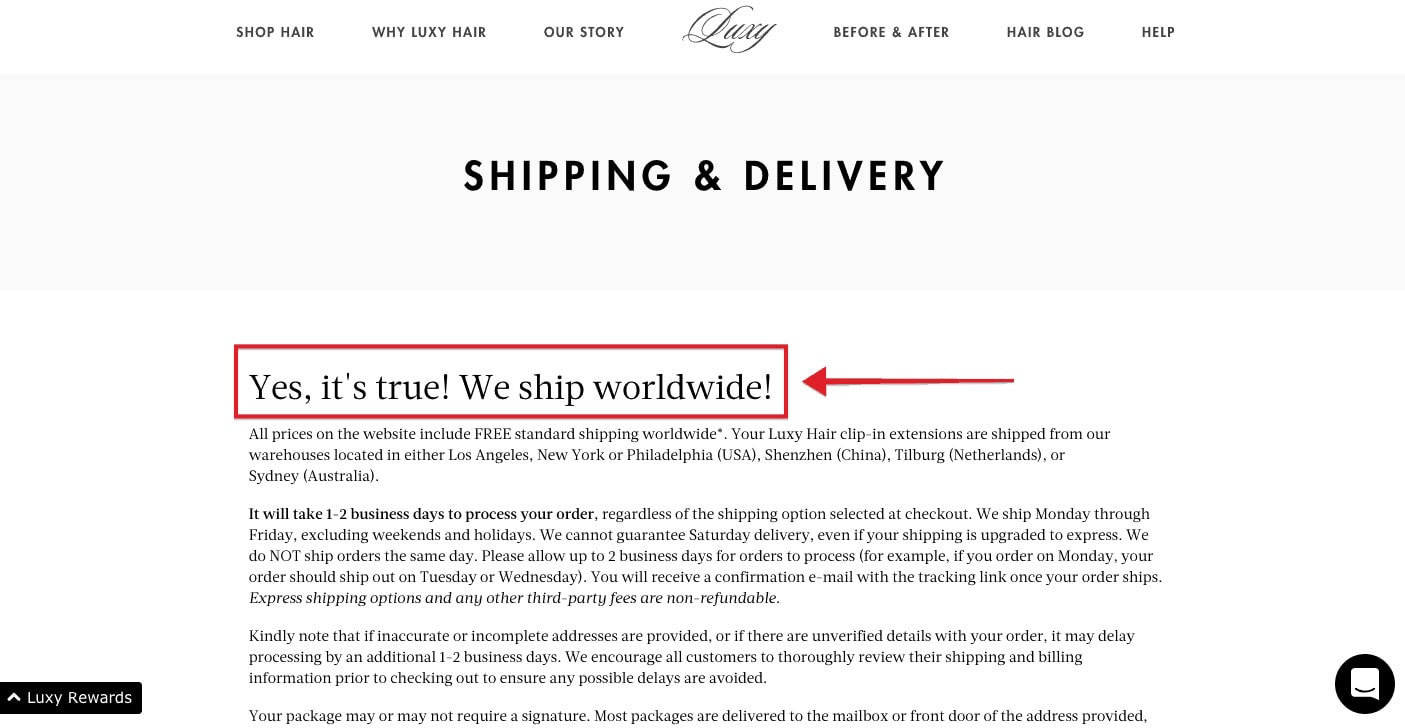
Luxy is self-aware enough to know customers may choose the wrong hair color. Because of this, they’ve created a very detailed return policy page that outlines everything so customers aren’t surprised, or confused.
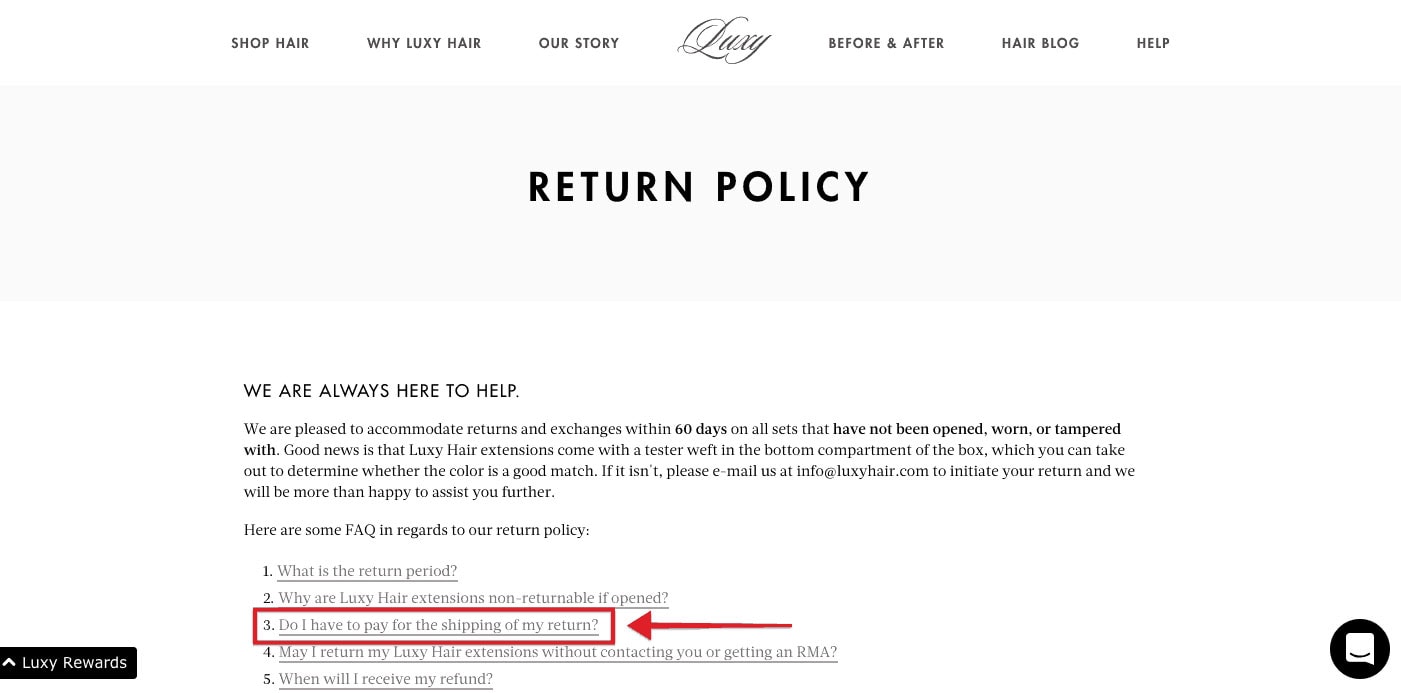
As you can see, Luxy has a list of FAQs on their policy page, which includes whether or not a customer is responsible to pay for the return cost of shipping.
The Importance of Communicating Free Shipping Policies
As all of the above examples show, your messaging will have a big effect on how customers respond to your shipping policy. Visitors need to know what to expect at the checkout, which in turn will help reduce their intent to abandon their shopping cart because of unexpected fees.
Here are a few ways to do just that:
- Add a banner to your website which clearly tells visitors what the shipping policy is
- Explain your shipping policy on the product pages
- Clearly outline your return shipping policy at the time of checkout
Free Shipping Business Spotlight: FIGS
Figs makes it very apparent what their return policy is the moment you land on their homepage.
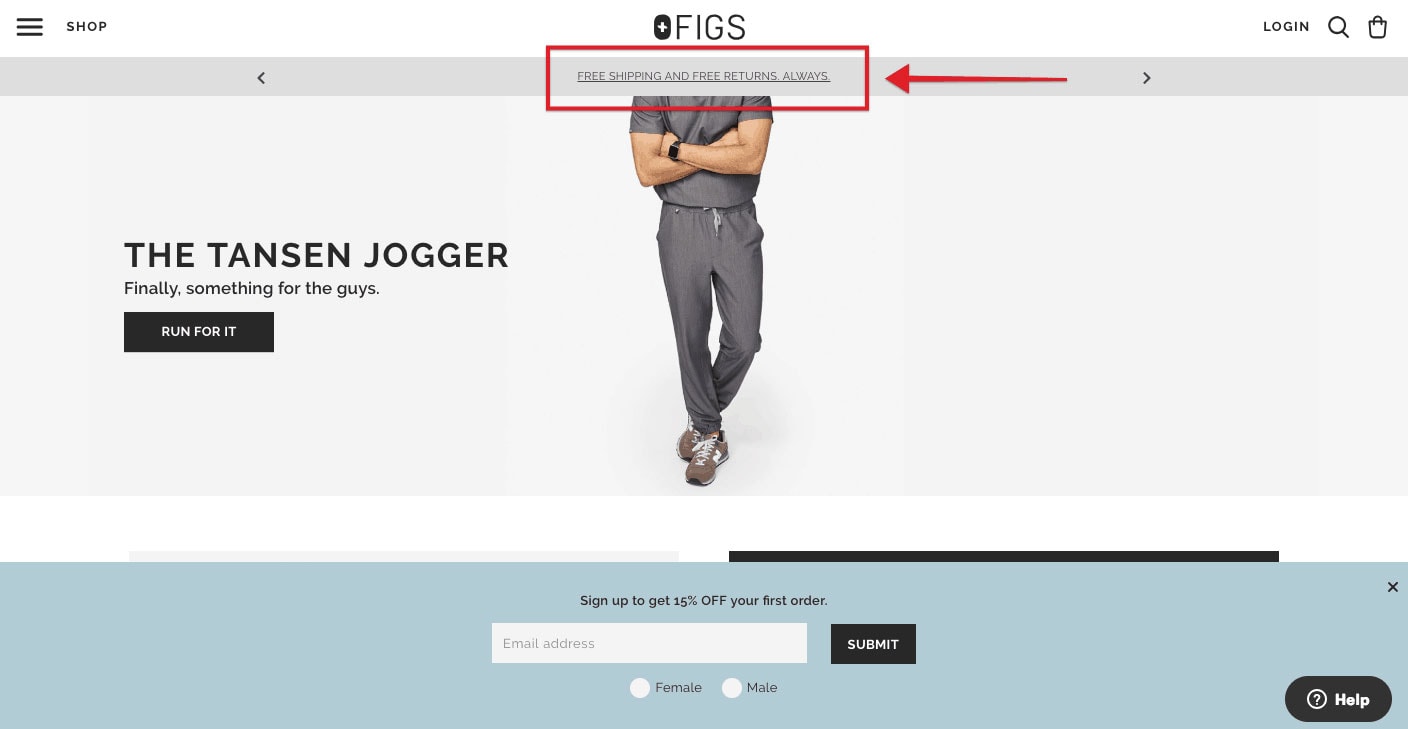
Not only do they place their shipping policy in the banner, they also add the word “always.” This one word makes a powerful difference. It tells customers they can trust that shipping and returns will be free, regardless of the circumstance.
Alright, now that you’ve communicated what your free shipping offer is to your customer, it’s time to test it out!
Test to Impress
The next step in this process is to determine how well your free shipping offer is working. It’s a good idea to roll it out as a promotion, rather than a policy to see if it’s worth it in the long haul. It can be challenging to test shipping offers, so here are some tips:
- Test Out the Promotion for 2 to 4 Weeks: This is a good baseline for the amount of time you should be experimenting and will give you a good idea if your offer is attracting the numbers you want.
- Avoid Highly Seasonal or Irregular Sales Periods: Don’t run your promotion during holidays or busy seasonal periods to ensure your data isn’t skewed by other cyclical business factors.
- Monitor & Inspect Your Metrics: Track your results from before, during and after the testing period to determine if the promotion is worth pursuing as a policy. Here, you’ll want to look at average order value, conversion and abandoned cart rates.
Conclusion
You’re now armed and ready to choose and test out your own free shipping policy. Free shipping is a proven, powerful marketing tool that can boost your conversion rates and increase customer satisfaction. You just need to test and iterate to figure out what works best for you and your customers!



